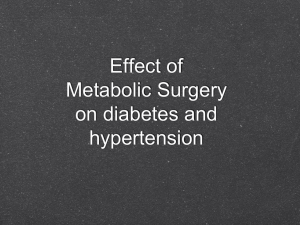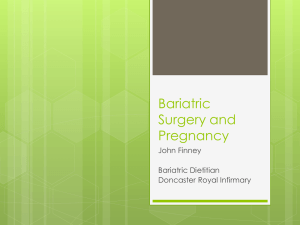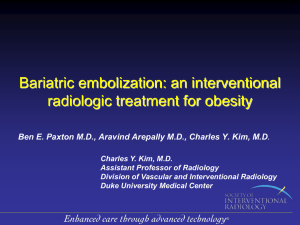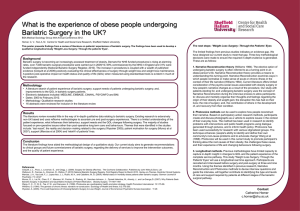View Presentation
advertisement
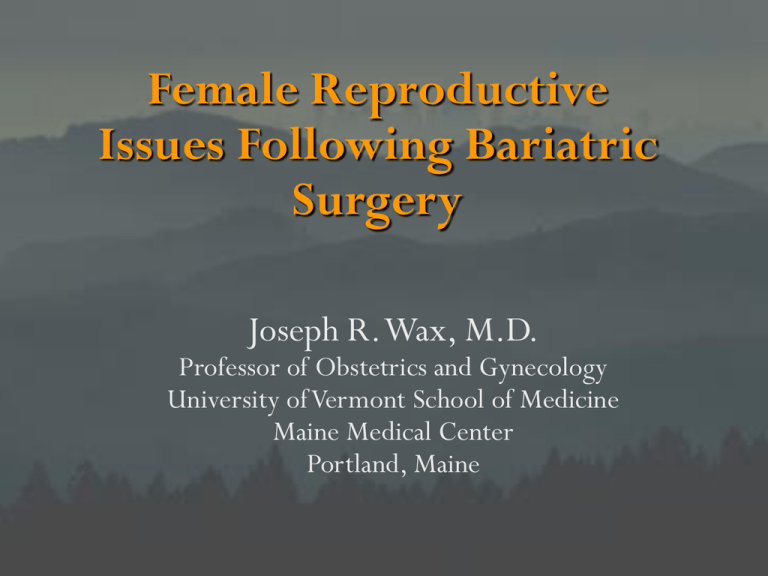
Female Reproductive Issues Following Bariatric Surgery Joseph R. Wax, M.D. Professor of Obstetrics and Gynecology University of Vermont School of Medicine Maine Medical Center Portland, Maine A Tale of Two Patients… 1. 25 year old G0 12 months after gastric bypass - Pre-conception care? Pregnancy management? 2. 35 year old G3P1011 at 21 weeks with 2 days progressive abdominal pain. RYGB 18 months earlier. - Differential diagnosis? Evaluation and treatment? Goals • Describe commonly performed bariatric procedures and implications for female reproductive health • Review consequences of bariatric surgery with regard to preconception care • Describe complications of bariatric surgery in pregnancy and their management • Review pregnancy outcomes following bariatric surgery Obesity in American Women Overweight or Obese Obese (BMI > 25) (BMI > 30) 62% 33% Extremely Obese (BMI > 40 or > 35 with comorbidity) 7% Ogden, C.L. JAMA 2006 Obesity-Related Morbidity Hypertension Dyslipidemia Arthritis Sleep Apnea Diabetes CAD Stroke Gallbladder Cancer -colon -breast -endometrial *Second leading cause of death* Obesity-Related Obstetrical Morbidity Infertility Miscarriage Gestational diabetes Hypertension Macrosomia Cesarean Anesthesia Blood loss Wound Infection Recent Trends in Bariatric Surgery • Almost 20-fold increase last decade – 2005 >100,000 – 2006 >200,000 • 5x as many procedures in women as men • >50% of all procedures in reproductive-aged women • Only effective treatment of morbid obesity CDC 2006 Bariatric Surgery – Prerequisites • • • • Multidisciplinary care Attempt non-surgical weight loss Preoperative medical evaluation Preconception consultation and care Bariatric Procedures – Roux-en-Y Gastric Bypass • Restrictive and malabsorptive • Lose – 100 lb – 65-70% EBW – 35% BMI • 0.5% mortality • 5% operative morbidity Buchwald, H. Obes Surg 2002 Roux-en-Y Gastric Bypass Laparoscopic vs. Open Laparoscopic Advantages Shorter hospital stay Open Tactile control of dissection Less post-operative Easier adhesiolysis discomfort Fewer wound complications Ability to use fine sutures Disadvantages Fewer cardiopulmonary complications Ease of performing ancillary procedures Fewer long-term complications Increased intra-abdominal complications Ventral hernia formation Simpfendorfer, C.H. Surg Clin N Am 2005 Bariatric Procedures – Laparoscopic Adjustable Gastric Banding • Restrictive • Lose – 50% EBW – 25% BMI • 0.1% mortality • 5% morbidity Buchwald, H. JACS 2005 Bariatric Procedures –Vertical Banded Gastroplasty • Restrictive • Efficacy, morbidity, mortality similar to LAGB Buchwald, H. Obes Surg 2002 Perioperative Reproductive Issues • Rapid weight loss over 12-18 months – Resolution of • PCOS • anovulation • irregular menses – Improved fertility and fecundity • Reliable contraception Teitelman, M. Obes Surg 2006 Eid, G. M. Surg Obes Rel Dis 2005 Bilenka, B. Acta Obstet Gynecol Scand 1995 Deitel, M. J Am Coll Nutr 1988 Gastric Bypass and Malabsorption • Supplements – ferrous sulfate or fumarate – B12 • 500-1000 µgm po qd or • 500-1000 µgm IM qm – folic acid • 400 µgm po qd – calcium citrate • 1200 mg po qd Preconception Care • Avoid MVI with > 5000 IU vitamin A • Address other obesity-related comorbidities – hypertension – diabetes – obesity Rothman, K. M. NEJM 1995 Late Surgical Complications in Pregnancy – Bowel Obstruction • 6-8% pregnancies -Internal hernia -Intussusception -Volvulus • 9-25 months after RYGB • Delay in diagnosis or treatment → 2 maternal and 1 fetal death Wax, J.R. OG Survey 2007 Bowel Obstruction in Pregnancy • Nonspecific nature of abdominal complaints • Confusion with common obstetrical phenomena • Distracted from inciting event by 2° pancreatitis * Have low threshold to consult bariatric surgeon* * Have low threshold to explore pregnant patient for obstruction* Internal Hernia in Pregnancy A. Lesser sac into mesocolic tunnel B. Petersen (below Roux limb) C. Leaves of small bowel mesentery Karkala, N OG 2005 Intussusception in Pregnancy • 21 weeks’ gestation • RYGB 18 months earlier • Several days abdominal discomfort • Six hours constant pain • Suspected internal hernia Wax, J.R. Obes Surg 2007 Late Surgical Complications in Pregnancy – Malabsorption • Iron deficiency – usually mild, responsive to oral therapy – rare cases of needing parenteral iron – recommend trimesterly CBC • Folate and B12 – continue preconception supplements – recommend MSAFP and targeted ultrasound Does Gastric Bypass Increase ONTD Risk? • 3 cases of ONTDs remote from RYGB (2-8 yrs) – no maternal vitamin supplements – 2 ↓B12, 1 ↓folate • Later studies – no ONTDs in 129 RYGB pregnancies – no increased risk of anomalies after bariatric surgery 15/289 cases vs. 6333/158,912 controls Haddow, J.E. Lancet 1986 Sheiner, C.S. AJOG 2004 Knudsen, L.B. Lancet 1986 Malabsorption and Carbohydrates Obesity RYGB Decreased caloric intake & absorption Hyperinsulinemic Hypoglycemia Pregnancy Insulin Resistance Pancreatic β cell hyperfunction Decreased fasting blood glucose Unfulfilled increased caloric intake Hyperinsulinemic Hypoglycemia • Diagnosis – glucose < 55 mg/dL – insulin ≥ 3 mcU/mL – c-peptide ≥ 0.6 ng/mL – no sulfonylurea Halverson, J.D. Surgery 1982 Hyperinsulinemic Hypoglycemia • Affects approximately 4% pregnancies • Treatment = Dietary Modification – Avoid refined/simple sugars – Increase • protein • complex carbohydrates – Consume liquids well before and after meals • Consult bariatric nutritionist Hyperinsulinemic Hypoglycemia in Pregnancy • • • • • 36-year old at 24 weeks RYGB 39 months earlier Lightheadedness, syncope Postprandial glucose 34-57 mg/dL Normal glucose, no symptoms after: – increase calories 1000 → 1500/day – increase protein 56g → 80g/day – avoid refined sugars Wax, J.R. Obes Surg 2007 Managing Dietary Failures • Rare, no reports in pregnancy • Reversal of bariatric procedure • Partial or total pancreatectomy Dumping Syndrome • Affects small proportion of RYGB patients • Can be associated with postprandial hyperinsulinemic hypoglycemia • Precipitated by liquids, simple, refined sugars Vecht, J. Scand J Gastroent Suppl 1997 Hasler,W.L. Curr Treat Options Gast 2002 Ukleja, A. Nutr Clin Pract 2005 Dumping Syndrome – Early Phase (10-30 min) Rapid transit of nutrients to small intestine Osmotic fluid shifts Vasomotor Symptoms • • • • • palpitations syncope diaphoresis flushing headache Abdominal Symptoms • • • • nausea diarrhea cramping bloating Dumping Syndrome – Late Phase (1-3 hrs) Reactive Hyperinsulinemic Hypoglycemia Vasomotor Symptoms Dumping Syndrome – Treatment • Dietary Modification – Avoid refined/simple sugars – Increase • protein • complex carbohydrates – Consume liquids well before and after meals Managing Dietary Failures • Rare, no reports in pregnancy • Medication – Acarbose (inhibits glucose absorption) • 25-50 mg after meals (TID) • S/E flatulence, diarrhea • category B – Octreotide (somatostatin analog) • 25-100 mcgm SQ 15-60 min before meals • category B Dumping Syndrome – Implications for Pregnancy • Avoid glucose challenge test – Home glucose monitoring • 1-2 weeks at 26-28 weeks • treat if consistently elevated Pregnancy Outcomes After Bariatric Surgery • Case reports and series • Case-control studies – small – subjects as own controls – women without bariatric surgery as controls • obese • non-obese – unspecified bariatric surgical procedure Pregnancy after LAGB Martin (n=23) Weiss (n=7) Skull* (n=49) Dixon*† (n=79) Years 1990-5 1996-2000 1996-2003 1995-2003 SAB 2 (9%) 2 (28.6%) - - CS 4 (22%) 2 (40%) 0 - BW 3676g - 0 0 - - ↓ ↓ DM 0 (0) 0 (0) ↓ ↓ HTN 0 (0) 0 (0) ↓ ↓ Band 0 (0) 2 (28.6%) 2 (4.1%) 0 (0) Outcome Wt gain * vs. last presurgical pregnancy † vs. matched obese controls Pregnancy After RYGB Outcome SAB CS BW ≥ 4 kg < 2.5 kg Preterm Wt gain DM HTN Printen (n=54) 2 (4.2%) 4 (8.7%) Wittgrove (n=36) 0 Richards (n=57) 0 Patel (n=26) 0 1078-4230g 7 (18.4%) 7 (15.2%) - ↓ 0 ↓ ↓ 0 0 ↓ ↓ ↓ ↓ 0 0 0 0 0 0 - ↓ 0 0 Pregnancy After RYGB Outcome Crude OR (95% CI) Adjusted * OR (95% CI) Hypertension 3.67 (1.36, 9.92) 2.62 (0.66, 10.50) PPROM 0.33 (0.04, 2.77) 0.24 (0.02, 3.38) Oligohydramnios 2.00 (0.65, 6.20) 2.39 (0.66, 8.61) Gestational age > 41 wks 0.50 (0.11, 2.36) 0.57 (0.11, 2.97) *adjusted for BMI at delivery Wax, J.R. et al Obes Surg 2008 Pregnancy After RYGB- Impact of Timing Outcome SAB Rand ( 10 early, 8 late) Dao (21 early, 13 late) Wax (20 early, 32 late) - 0 - CS 0 0 0 BW - 0 0 Preterm - 0 0 Wt gain - 0 DM - - 0 HTN - 0 0 Pregnancy After LAGB/RYGB Compared to Pre-Surgical Pregnancy Less Similar Unclear Wt gain CS SAB DM BW Growth restriction HTN Preterm BW ≥ 4kg Bariatric Surgery and the Puerperium • Weight loss – limited descriptive data – rate similar to nonbariatric delivered patients and nonpregnant bariatric patients Bariatric Surgery and Lactation • Not contraindicated • Ensure maternal B12 supplementation – several cases of neonatal B12 deficiency Grange, D.K. Pediatr Hematol Oncol 1994 Campbell, C.D. Haematologica 2005 Summary • Anatomic and physiologic changes associated with bariatric surgery have significant reproductive implications • Nutritional deficiencies generally mild and easily treated • Limited data suggest favorable pregnancy outcomes Future Research • Pregnancy outcome – by specific bariatric procedure – account for • past pregnancy complications • persistent obesity • obesity-related comorbidities – congenital anomalies (ONTDs) Guidelines for Care Preconception Reliable contraception through period of maximal weight loss Evaluate and treat comorbidities Evaluate and treat micronutrient deficiencies (B12, folate, iron) Meet with bariatric surgeon and nutritionist, preconception consultation with Ob/Gyn or Maternal-Fetal Medicine Folic acid, B12 and iron supplementation Pregnancy Folic acid, B12 and iron supplementation Second trimester MSAFP Consider monthly growth ultrasounds after 20 weeks Monitor for signs and symptoms of hypoglycemia Avoid NSAIDS if history of ulcer Puerperium Folic acid, B12 and iron supplementation Breast feeding compatible with bariatric surgery Notify pediatrician of maternal surgical history to enable monitoring for micronutrient deficiency (likely very low risk if mother taking prescribed supplements) Wax, J.R. OG Survey 2007 Avoid NSAIDS if history of ulcer


